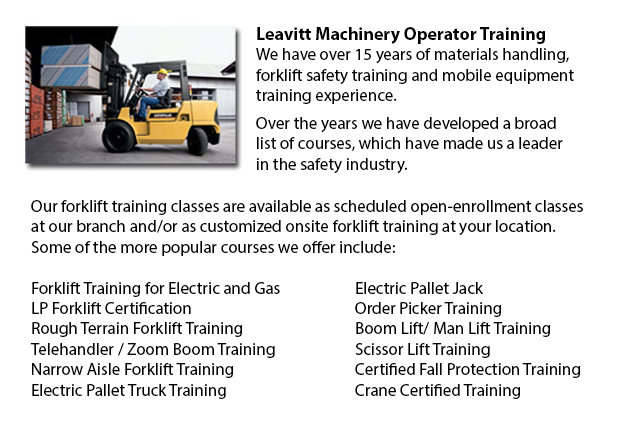
Forklift Training Schools British Columbia - What Are Included In Our Forklift Training Schools
If you are searching for work as a forklift operator, our regulatory-compliant forklift training Schools provide excellent instruction in numerous types and styles of forklifts, classes on pre-shift check, fuel kinds and dealing with fuels, and safe operation of a forklift. Practical, hands-on training assists participants in acquiring basic operational skills. Program content comprises existing regulations governing the use of forklifts. Our proven forklift Schools are intended to provide training on these types of trucks: narrow isle forklift, counterbalanced forklift and powered pallet truck.
Do not lower or raise the fork whilst the lift truck is moving. A load must not extend higher than the backrest due to the possibility of the load sliding back toward the operator. Inspect for overhead obstacles and make certain there is enough clearance prior to raising a load. Stay away from overhead power lines. Once the load is raised straight up, tilt it back slightly.
When the load is raised the forklift will be less stable. Make certain that no pedestrians cross below the elevated fork. The operator should not leave the forklift when the load is lifted.
When handling pallets, forks must be level and high enough to go into the pallet and extend all the way under the load. The fork's width should provide even distribution of weight.
Set the brakes and chock the wheels before unloading and loading the truck. The floors must be strong enough to support the weight of both the forklift and its load. Fixed jacks could be installed to be able to support a semi-trailer that is not coupled to a tractor. The entrance door height must clear the height of the forklift by a minimum of 5 cm. Mark edges of ramps, docks or rail cars and avoid them.
-
Warehouse Forklift Safety Training British Columbia
Warehouse Forklift Safety Training British Columbia - The corporation would face claims for liability when damage and injuries are sustained in an accident at the workplace. Warehouses can be a hazardous place to work for its workers, making employee... More -
Loader Operator Certification British Columbia
Loader Operator Certification British Columbia - Courses Offered For Getting Loader Operator Certification - Certification for forklifts are required to guarantee the safe operation of forklifts for those employers in industrial, warehouse or constru... More -
Crane / Overhead Crane / Self-Erect Crane / Truck Mounted Crane / Hydraulic Cranes Training in British Columbia
Bridge cranes or likewise called overhead cranes are actually a type of industrial material handling crane making use of a line and hook device that runs on a horizontal beam running along two widely separated rails. Numerous overhead cranes could be... More -
Scissor Lift License British Columbia
Scissor Lift License British Columbia - The operation of scissor lifts carries an inherent chance of danger. Whichever type of powered machine requires correct handling to prevent accidents causing injury or damage. Companies need to make certain tha... More -
Heavy Equipment Training Schools British Columbia
Heavy Equipment Training Schools British Columbia - There are a lot of heavy equipment training schools to select from. If you want to get to the best, it is important to check various aspects of the school in order to ascertain the level of educatio... More -
Telehandler Training British Columbia
Telehandler Training British Columbia - Telescopic handlers usually called telehandlers for short, are an extremely popular piece of heavy construction equipment. They are commonly utilized in the construction and agricultural trades. These machines... More -
Forklift Training Courses British Columbia
Forklift Training Courses British Columbia - When forklift operator safety training is tailored for illiteracy, training time is lessened by 50%. Forklift training certification, lift-truck operator driver safety training evaluation, and train the tr... More -
Heavy Equipment Operator Training British Columbia
Heavy Equipment Operator Training British Columbia - Heavy equipment operator training facilities which provide quality standards in the business, providing field performance work and added machinery training are highly sought after training features... More

Forklift Training British Columbia
TOLL FREE: 1-888-254-6157
forklifttrainingbritishcolumbia.com
Email Us
About Us


